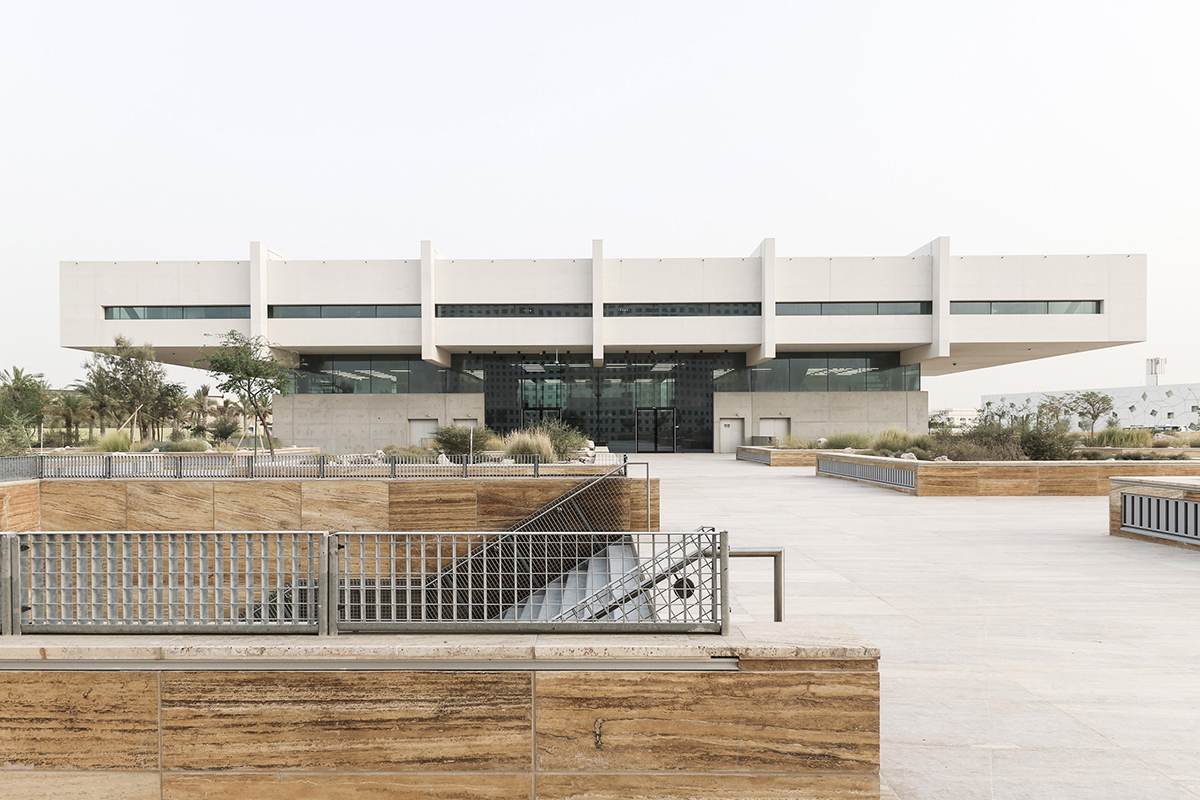The recent work of OMA in Qatar gives a glimpse of their independence from Rem
Rem Koolhaas announced the ceasing of his involvement in his legendary architecture firm and that such decision would allow for OMA’s offices operating in different regions to have an ‘independent voice’ where they would be given the freedom to determine their own creative and professional directions. The decision will offer him a chance to pursue the projects he’s personally interested in such as his role as the curator for the Venice Architecture Biennale back in 2014. The news broke and caused quite a stir and criticism, particularly in the Internet world, even a tease that the OMA empire under the absolute reign of Rem Koolhaas had finally reached its Postcolonial era. When asked what the strategy in the architectural world would be that would keep the OMA brand alive, Koolhaas replied that he is personally opposed to the idea of branding for, in most cases, the concept is conceived from one’s attempt to define the essence of something before it is used to dictate everything else. Eventually, branding ends up being a limitation that prevents one from doing things that may have not been determined.
In this case, Qatar Foundation Headquarters in Doha, the latest project by OMA Dubai, is the quintessential reflection of Koolhaas’ notion of an ‘independent voice’ that is about to happen with other offices run by OMA’s partners in other regions. The project is overseen by Iyad Alsaka, one of the partners and directors of OMA’s Middle Eastern projects with Kunlé Adeyemi, a Nigerian architect being responsible for almost the entire architectural design of the building.
Considering the content and physical attributes of the project, Qatar Foundation Headquarters bears a certain distinction from OMA’s previous work for we barely see any trace of pragmatism, ideas communicated through diagrams or the use of models to experiment with the building’s usage, which contributes to the specific nature of the spaces and program of most of OMA’s architectures. If there were the utilization of such techniques in the working process, we can hardly see the attempt to communicate such elements as we did in the firm’s past projects that most are familiar with.

With the main functionality of an office building, the large cubical mass of the architecture bears the height of 58 meters. The exterior surface of precast white concrete contains openings that create a series of square grids of various sizes. The configuration gives birth to the outline of a Sidra tree, the symbol of the Qatar Foundation. Such detail is an attempt to communicate the organization’s identity through the presence of the façade, which seems to generate somewhat of a rather negative more than positive final outcome, for the design makes it hard for one to make the connection with the symbol of the Qatar Foundation as the architect had intended.
The 29,000-square-meter capacity of the functional space hosts three main zones: the Executive Tower, Staff Tower and Her Highness’s wing. The latter is the area used to accommodate Sheikha Mozah bint Nasser Al Missned, the founder of the Qatar Foundation. All areas can be accessed through a glass walkway via the spacious atrium located right in the middle of the building that links different interior spaces together.
Another interesting element of the building is the terrace on the 7th floor that opens to the unobstructed view outside. The main building is neighbored with a 3-story structure, which functions as the Strategy Study Center. The top floor is designed to extend from the rest of the building’s mass below with an area that houses a space where meetings are held. In addition to Iyad Alsaka who is in charge of the Dubai office, OMA has several other partners overseeing projects in different offices around the world, from Shohei Shigematsu in New York and Reinier de Graaf in the United Kingdom to David Gianotten in Hong Kong. What is very interesting to consider from now on is, with Rem Koolhaas retiring, how these ‘independent voices’ can be harmonized and how they will contribute to change and the future of OMA. Will they be able to develop in the same direction or be ramified and determined by each partner’s architectural identity like what Iyad Alsaka did with the Dubai office’s latest project?

เมื่อช่วงปลายปี 2016 ที่ผ่านมา Rem Koolhaas ได้ให้สัมภาษณ์ผ่านสื่อว่า นับแต่นี้ไปเขาจะเปิดโอกาสให้ออฟฟิศของ OMA ในแต่ละภูมิภาคได้มี “independent voice” หรือ มีอิสระในการทำงานและกำหนดแนวทางในการทำงานของตัวเอง โดยที่เขาจะไม่เข้าไปยุ่งเกี่ยว เพื่อที่เขาเองจะได้มีเวลาทำอะไรอย่างที่อยากทำา เหมือนอย่างเช่นการเป็นภัณฑารักษ์ในงาน Venice Architecture Biennale เมื่อปี 2014 ข่าวการเปลี่ยนแปลงรูปแบบการทำงานในครั้งนี้ของ OMA สร้างความฮือฮาและเป็นที่วิพากษ์วิจารณ์ในโลกออนไลน์พอสมควร ถึงกับมีการแซวกันแบบขำๆ ว่า จักรวรรดิยักษ์ใหญ่อย่าง OMA ที่ปกครองโดย Rem Koolhaas ได้เดินทางมาถึงยุค Postcolonial เสียแล้ว เมื่อถูกถามว่าอะไรคือยุทธศาสตร์ในโลกสถาปัตยกรรมที่ทำให้ความเป็น brand ในอนาคตของ OMA ยังคงอยู่ Rem Koolhaas ได้ ตอบคำาถามนี้ว่าตัวเขาเองค่อนข้างต่อต้านไอเดียเรื่อง branding เพราะโดยมากแล้ว branding มักเกิดจากการพยายามนิยามว่าอะไรคือสาระสำคัญ จากนั้นเราก็นำมันไปกำหนดทุกๆ สิ่งที่จะเกิดขึ้น จนกลายเป็นข้อจำกัดทำให้เราทำในสิ่งที่อยู่นอกเหนือไปจากสิ่งที่กำหนดเอาไว้ไม่ได้
ในกรณีนี้ Qatar Foundation Headquarters ที่ Doha ผลงานการออกแบบชิ้นล่าสุดของออฟฟิศ OMA ในดูไบ น่าจะสะท้อนภาพความเป็น “independent voice” ที่กำลังจะเกิดขึ้นกับออฟฟิศที่ดูแลโดย partner ของ OMA ในภูมิภาคต่างๆ ที่ Koolhaas อธิบายเอาไว้ให้เราสามารถพอเห็นภาพได้ โครงการนี้ดูแลรับผิดชอบโดย Iyad Alsaka หนึ่งใน partner ที่เป็นผู้ดูแลงานในภูมิภาคตะวันออกกลางและแอฟริกาของ OMA โดยมี Kunlé Adeyemi สถาปนิกชาวไนจีเรียเป็นผู้รับผิดชอบหลักในการออกแบบเกือบทั้งหมด
หากลองพิจารณาเนื้อหาและลักษณะทางกายภาพของโครงการโดยรวมจะเห็นได้ว่าโครงการนี้ค่อนข้างแตกต่างไปจากผลงานชิ้นอื่นๆ ของ OMA เพราะเราแทบจะไม่เห็นกลิ่นอายของความเป็น pragmatism ไม่เห็นการสื่อสารความคิดผ่าน diagram หรือการทดลองทำงานผ่านหุ่นจำลอง ที่จะทำให้เกิดลักษณะเฉพาะบางอย่างของที่ว่างและโปรแกรมของพื้นที่ส่วนต่างๆ ของอาคารเลย หรือถ้ามีการใช้เทคนิคที่ว่านี้ในกระบวนการทำงาน เราก็แทบไม่เห็นความพยายามในการสื่อสารสิ่งเหล่านี้ออกมาให้เห็นเหมือนผลงานที่ผ่านๆ มาของ OMA ในเแบบที่เราคุ้นเคย
ด้วยลักษณะอาคารสำานักงานหลักที่มีลักษณะเป็นรูปทรงลูกบาศก์ขนาดใหญ่ ความสูง 58 เมตร ผิวภายนอกของผนังอาคารเป็น precast white concrete ที่เจาะช่องเปิดให้เห็นเป็น grid สี่เหลี่ยมจัตุรัสขนาดเล็ก-ใหญ่ ให้เป็นรูปต้นซีดาร์ซึ่งเป็นสัญลักษณ์ของ Qatar Foundation นับเป็นความพยายามที่จะสื่อสารผ่าน façade ซึ่งดูแล้วก็น่าจะให้ผลลัพธ์ที่ล้มเหลวมากกว่าที่จะประสบความสำเร็จ เพราะด้วยรูปลักษณ์ของ facde ยากที่จะเชื่อมโยงมันกับสัญลักษณ์ของ Qatar Foundation ในแบบที่สถาปนิกต้องการได้
ภายในอาคารที่มีพื้นที่กว่า 29,000 ตารางเมตร แบ่งออกเป็นพื้นที่หลักๆ ด้วยกัน 3 ส่วน คือ The Executive Tower, Staff Tower และ Her Highness’s wing ที่เป็นพื้นที่สำหรับพระชายาของเจ้าผู้ครองรัฐการ์ตาองค์ปัจจุบันซึ่งเป็นผู้ร่วมก่อตั้งมูลนิธิที่มีชื่อว่า โมซา บินตินัซเซอร์ อัลมิซเนด (Sheikha Mozah bint Nasser Al Missned) พื้นที่ทั้งหมดสามารถเข้าถึงด้วยการเดินผ่านทางเดินกล่องกระจกบริเวณ atrium ขนาดใหญ่ตรงกลางอาคารที่ทำาหน้าที่เชื่อมโยงพื้นที่ว่างภายในอาคารส่วนต่างๆ เข้าไว้ด้วยกัน พื้นที่อีกส่วนที่คิดว่าน่าสนใจของอาคารนี้คือบริเวณพื้นที่ชั้นที่ 7 ที่เป็น terrace ที่เปิดมุมมองให้เห็นวิวภายนอกโดยปราศจากเสา นอกจากอาคารหลังนี้แล้ว ภายในพื้นที่โครงการยังมีอาคารสูง 3 ชั้น อยู่ข้างๆ อาคารหลัก ที่ออกแบบให้เป็น Strategy Study Center โดยชั้นบนสุดของอาคารถูกออกแบบให้ยื่นออกมาจากพื้นที่ชั้นอื่นๆ เพื่อใช้เป็นสถานที่สำหรับจัดงานประชุมอีกด้วย
นอกจาก Iyad Alsaka ที่รับผิดชอบดูแลออฟฟิศที่ดูไบแล้ว OMA ยังมี partner ที่ดูแลรับผิดชอบอยู่ในออฟฟิศต่างๆ อีกหลายคนในพื้นที่ต่างๆ ทั่วโลก ไม่ว่าจะเป็น Shohei Shigematsu ที่นิวยอร์ก Reinier de Graaf ในสหราชอาณาจักร และ David Gianotten ในฮ่องกง มันจึงน่าสนใจไม่ใช่น้อยว่าต่อจากนี้ไปเมื่อ Rem Koolhaas วางมือลงแล้ว independent voice ทั้งหมดของ OMA จะส่งเสียงสอดประสานกันและเปลี่ยนแปลงความเป็น OMA ในภาพรวมไปในทิศทางใด OMA จะมีภาพรวมไปในทิศทางเดียวกันหรือจะแตกต่างหลากหลายไปตามแนวทางของ partner แต่ละคนในแบบที่ Iyad Alsaka ได้ทำให้เราเห็นแล้วในงานของ OMA ของออฟฟิศที่ดูไบ
TEXT : WICHIT HORYINGSAWAD
PHOTO : YUEQI ‘JAZZI’ LI
qf.org.qa
oma.eu

